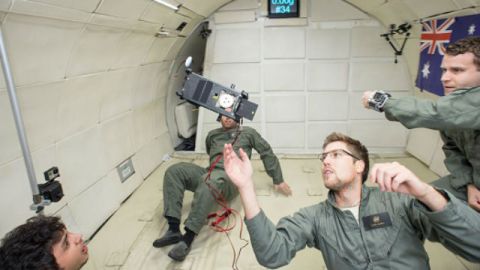Profiting from Re-Entry: How NewSpace Needs Public Policy to Take Space Debris Out of the Equation

To take an idea and put it into Earth’s orbit requires the dedication of an incredible amount of time, energy, and resources to not only the payload itself, but also to all of the crucial elements that make up the NSG 4 Screens. What is even more astounding is how all of that hard work can be lost in an instant when a rogue piece of space junk collides with a functioning, potentially profit-producing spacecraft. At this moment, trapped in the Earth’s eternal gravitational hold are over 500,000 pieces of debris ranging in size and substance, from puny paint flecks to colossal spent fuel stages.
While the accumulation of debris until now has had a minimal impact on space operations, the potential threat space debris poses to companies throughout the NSG 8 Verticals is clear, costly, and growing. But where there are debris problems in space, there are new market opportunities for entrepreneurs and innovators in NewSpace. And with the help of some carefully crafted public policies, NSG SmallCaps and others like Tethers Unlimited, Saber Astronautics, Altius Space Machines, Swiss Space Systems, Astrium, Intelsat, Space Systems / Loral, and MDA can capitalize on mitigating the threat of space debris. (Please see “SmallCap Review” in the Premiere issue of Thruster.)
Keeping space debris in check requires two modes of attack: first, we must find ways to remove the existing garbage, and second, we must find ways to prevent future activities in space from contributing to the problem. A wide range of technologies has been proposed to address both of these concerns. Some of these plans include the use of solar sails, slingshots, mile-wide debris nets made up of NanoSatellites, robotic arms, electrodynamic tethers, even lasers to zap the space rubbish, all of which would bring the junk to a fiery demise upon reentry into the Earth’s atmosphere. However, what’s missing is strong demand from paying customers: i.e. the 2nd Screen for these 4th Screen pursuits. (Please see “SmallCap Review” in the December 2012 issue of Thruster.) With only a few major incidents – e.g. the French satellite that was damaged in 1996 by debris from a French rocket that exploded 10 years prior, and the loss of Iridium’s SV33 Communication satellite to the Russian Cosmos 2251 satellite in 2009 – the threat space debris poses is generally not perceived as a major one. As Jason Held, Director at SABR told NSG: “We don’t hear the commercial industry complaining about it in a major way. We only hear the academic community saying the sky is falling.” In the eyes of the 1st Screen there are more formidable threats to their payloads’ success than space debris; hence, why companies sending satellites into orbit have very little incentive to purchase the components necessary to orbit craft, and ironically, are only making the problem worse with every launch.
The lack of damage caused by space debris has also led to a laggard public policy approach in drafting the necessary legislation that would allow NSG SmallCaps to nip this problem in the bud. Held asked “Who owns the debris up there? If you’ve got a CubeSat that cost $150,000 to get into orbit, and it hits another far more expensive satellite – whose fault is it?” Rob Hoyt, CEO & Chief Scientist at TUI, cited Article VIII of The Outer Space Treaty which states that space objects, including non-functioning satellites and other space debris, continue to belong to the country or countries that launched them. But in the event of a collision, as Held alludes to, would such a treaty apply or even be enforced against the host country? Held told NSG that “no market exists for this right now so [the ownership of space debris] becomes an insurance/litigation issue. Can you sue them [i.e. the host country at fault]? If you can sue them then you have a market.” The lack of precedent with respect to space debris litigation issues creates uncertainty that is unhealthy for any market, but it presents an opportunity for public policy makers to create legislation that can yield enormous savings down the road for companies on the NSG 100, NSG OTB and NSG PTC.
Mike Lawton, Founder and Managing Director of UK-based Oxford Space Systems, told NSG: “Space debris has been addressed with a very large, institutional approach.” Government agencies like the United States Air Force, DARPA, and others have monitored the debris through programs such as the Space Fence and Space Surveillance Network, and ESA has held forums and conferences to discuss the issues surrounding space debris – resulting in an in depth knowledge of the issue. (Please see “Point-to-Point: Western Europe” in this issue of Thruster.)
However, as space rubble increasingly interferes with NewSpace operations, “does the government really need to be involved in the act of clearing space debris?” asked Held; “I can only see that happening if the problem were to be super critical.” (Please see “Letter From the Editor” in the April 2013 issue of Thruster.) Lawton speculates about the public sector’s role in the mitigation of space debris with a sense of humor: “When you look at the latest headline grabbing mission from India – putting a probe on its way to Mars for around $45Mln dollars, I half-jokingly say that ESA and NASA cannot even do the paperwork on a program for that amount of money. So we’ve got to wake up, we’ve got to do things differently.” Instead of states throwing money at trying to round up space debris, Held insists that governments need to stick to sensible regulations, and “design the regulation[s] to induce growth. That should be the goal of anybody doing some sort of public policy, and that should be the role of government: create laws that create growth.”
An example of such a regulation at work is a NASA Technical Standard outlined in its Process for Limiting Orbital Debris (PLOD). Requirement 4.3-1a states that all debris released during the deployment, operation, and disposal phases shall
be limited to a maximum orbital lifetime of 25 years from date of release. Hoyt of TUI told NSG that his company’s “focus right now is on the de-orbit devices that will go on spacecraft to enable them to meet the 25-year orbital lifetime requirement because that is a market that exists now.” To date, TUI has sold two units of its very small and “very affordable” Terminator Tape systems, both of which are currently in orbit on CubeSats built by The Aerospace Corporation. TUI is also developing a larger version of the Terminator Tape that will be suitable for spacecraft in the 500 to several thousand kg range, and the company hopes to secure an opportunity to test this device sometime in the near future. (Please see “Space Scalable” in the March 2013 issue of Thruster.)Lawton of OSS sees the need for growth-inspired space debris regulations as well because “until someone is actually fined for noncompliance, I’m struggling to see why a platform operator would incur the overhead of fitting additional hardware to its platform unless it’s actually going to be fined for not de-orbiting its craft.” In addition to implementing legislation with some “legal teeth behind it,” Lawton urges governments to unlock the potential of SMEs (small and medium enterprises) through the sponsorship of technology demonstration platforms or Tech DemoSats as they are called. In fact, the UK’s TechDemoSat-1, which was built by Surrey Satellite Technology (SSTL), features a de-orbiting sail and is set to launch in Q2 2014. (Please see “SmallCap Review” in the October 2013 issue of Thruster.) Similarly, the Japanese Space Agency (JAXA) is launching a SmallSat that will capture debris with a specially designed, 700-metre-long magnetic net, and de-orbit the junk using an electrodynamic tether that interacts with the Earth’s ionosphere.
Held believes governments’ role should be for “applying standards for de-orbit, supersinking, and for cleanliness of launch.” SABR, the makers of the DragEN de-orbiting tether for NanoSatellites, is currently targeting the CubeSat market because of its lower barrier to entry, uniformity, and ease in mitigation as far as space debris is concerned, but its ambitions do not stop there. (Please see “SmallSat Review” in the March 2014 issue of Thruster.) Despite the foreseeable6th Vertical market uncertainty, Held said: “We want to find ways to use debris in interesting ways if possible. We’re looking at towing scenarios, we’re talking to other companies that are planning to do tow themselves and we want to be a part of those solutions.” Looking beyond towing scenarios that would use the power of a spacecraft to intentionally de-orbit space junk, Held takes SABR’s forward thinking even further: “There’s all this material up there that you can use, so if you could find a way to drag it to a logistics site…“ Held notes that there is no foundry in space yet that would allow for in-space recycling, but he insists that “if you think of space debris as a logistics problem instead of an insurance problem, then there are [market] opportunities.” (Please see “SmallCap Review” in the December 2012 issue of Thruster.)
While the addition of debris from future space activities seems to be a source of pollution that we can limit and/or manage, taking care of the existing debris presents a messy slew of potential legal challenges. Before those in the 6th Vertical can start “taking out the orbital trash,” questions over liability issues, the potential for space junk to be used as a weapon, and the threat of functioning satellites being commandeered by de-orbiting craft, even questions over the definition of what makes a defunct satellite space junk in the first place, must be addressed. (Please see “Public Policy” in the April 2013 issue of Thruster.) Hoyt, whose company has been actively working on the technology that will enable the remediation of space debris, and who was recently awarded a Phase II SBIR to develop a launchable anchor system bent on capturing debris, explained it this way: “In terms of cleaning up the orbital debris that is already up there, right now there is no organization that has the mandate and the funding to actually do that, so although various agencies and organizations are studying the problem – as of now we don’t know anyone who’s got the job to take care of that. So we’re developing the technology to enable that to be done, but we’re kind of waiting for the funding and the regulatory environment to come into place so that there will actually be a business opportunity there. There isn’t a business opportunity yet…it will require regulatory and/or government agency funding.” (Please see “Investor Watch” in the April 2013 issue of Thruster.)
According to some experts, the continued anthropogenic pollution of space will result in larger costs for those who dare to dabble in especially low Earth orbit (LEO); however, instead of neglecting this issue until NewSpace is faced with a gauntlet of moving garbage in space, we can continue to grow the 8 Verticals by giving the aforementioned companies permission to send the junk packin’ back into the Earth’s atmosphere. With some further development in the area of public policy, these ambitious NSG SmallCaps and others alike will have the legislative backing to capitalize on its innovations and ultimately, clear a path for the rest of NewSpace to go about its own, innovative, business as usual.
Cory Harrigan is an Analyst Intern at NewSpace Global and frequent contributor to Thruster.





